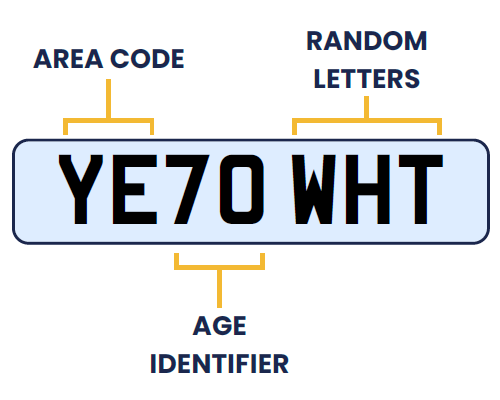| AA, AB, AC, AD, AE, AF, AG, AH, AJ, AK, AL, AM, AN | Anglia (Peterborough) |
| AO, AP, AR, AS, AT, AU | Anglia (Norwich) |
| AV, AW, AX, AY | Anglia (Ipswich) |
| BA, BB, BC, BD, BE, BF, BG, BH, BJ, BK, BL, BM, BN, BO, BP, BR, BS, BT, BU, BV, BW, BX, BY | Birmingham (Birmingham) |
| CA, CB, CC, CD, CE, CF, CG, CH, CJ, CK, CL, CM, CN, CO | Cymru (Cardiff) |
| CP, CR, CS, CT, CU, CV | Cymru (Swansea) |
| CW, CX, CY | Cymru (Bangor) |
| DA, DB, DC, DD, DE, DF, DG, DH, DJ, DK | Deeside to Shrewsbury (Chester) |
| DL, DM, DN, DO, DP, DR, DS, DT, DU, DV, DW, DX, DY | Deeside to Shrewsbury (Shrewsbury) |
| EA, EB, EC, ED, EE, EF, EG, EH, EJ, EK, EL, EM, EN, EO, EP, ER, ES, ET, EU, EV, EW, EX, EY | Essex (Chelmsford) |
| FA, FB, FC, FD, FE, FF, FG, FH, FJ, FK, FL, FM, FN, FP | Forest and Fens (Nottingham) |
| FR, FS, FT, FV, FW, FX, FY | Forest and Fens (Lincoln) |
| GA, GB, GC, GD, GE, GF, GG, GH, GJ, GK, GL, GM, GN, GO | Garden of England (Maidstone) |
| GP, GR, GS, GT, GU, GV, GX, GY | Garden of England (Brighton) |
| HA, HB, HC, HD, HE, HF, HG, HH, HJ | Hampshire and Dorset (Bournemouth) |
| HK, HL, HM, HN, HO, HP, HR, HS, HT, HU, HV, HX, HY | Hampshire and Dorset (Portsmouth) |
| HW | Exclusive: Isle of Wight (Portsmouth) |
| KA, KB, KC, KD, KE, KF, KG, KH, KJ, KK, KL | (Luton) |
| KM, KN, KO, KP, KR, KS, KT, KU, KV, KW, KX, KY | (Northampton) |
| LA, LB, LC, LD, LE, LF, LG, LH, LJ | London (Wimbledon) |
| LK, LL, LM, LN, LO, LP, LR, LS, LT | London (Stanmore) |
| LU, LV, LW, LX, LY | London (Sidcup) |
| MA, MB, MC, MD, ME, MF, MG, MH, MJ, MK, ML, MM, MN, MO, MP, MR, MS, MT, MU, MV, MW, MX, MY | Manchester and Merseyside (Manchester) |
| NA, NB, NC, ND, NE, NF, NG, NH, NJ, NK, NL, NM, NN, NO | North (Newcastle) |
| NP, NR, NS, NT, NU, NV, NW, NX, NY | North (Stockton) |
| OA, OB, OC, OD, OE, OF, OG, OH, OJ, OK, OL, OM, ON, OO, OP, OR, OS, OT, OU, OV, OW, OX, OY | Oxford (Oxford) |
| PA, PB, PC, PD, PE, PF, PG, PH, PJ, PK, PL, PM, PN, PO, PP, PR, PS, PT | Preston (Preston) |
| PU, PV, PW, PX, PY | Preston (Carlisle) |
| RA, RB, RC, RD, RE, RF, RG, RH, RJ, RK, RL, RM, RN, RO, RP, RR, RS, RT, RU, RV, RW, RX, RY | Reading (Reading) |
| SA, SB, SC, SD, SE, SF, SG, SH, SJ | Scotland (Glasgow) |
| SK, SL, SM, SN, SO | Scotland (Edinburgh) |
| SP, SR, SS, ST | Scotland (Dundee) |
| SU, SV, SW | Scotland (Aberdeen) |
| SX, SY | Scotland (Inverness) |
| VA, VB, VC, VD, VE, VF, VG, VH, VJ, VK, VL, VM, VN, VO, VP, VR, VS, VT, VU, VV, VW, VX, VY | Severn Valley(Worcester) |
| WA, WB, WC, WD, WE, WF, WG, WH, WJ | West of England (Exeter) |
| WK, WL | West of England (Truro) |
| WM, WN, WO, WP, WR, WS, WT, WU, WV, WW, WX, WY | West of England (Bristol) |
| YA, YB, YC, YD, YE, YF, YG, YH, YJ, YK | Yorkshire(Leeds) |
| YL, YM, YN, YO, YP, YR, YS, YT, YU | Yorkshire (Sheffield) |
| YV, YW, YX, YY | Yorkshire (Beverley) |

